“I wanted to be a beginner again and feel like I was growing.”
Those words from designer/director Erica Gorochow encapsulate the primary motivation behind deciding to take on what ended up being a year-and-a-half long challenge: creating Specimen, a color matching game for iOS.
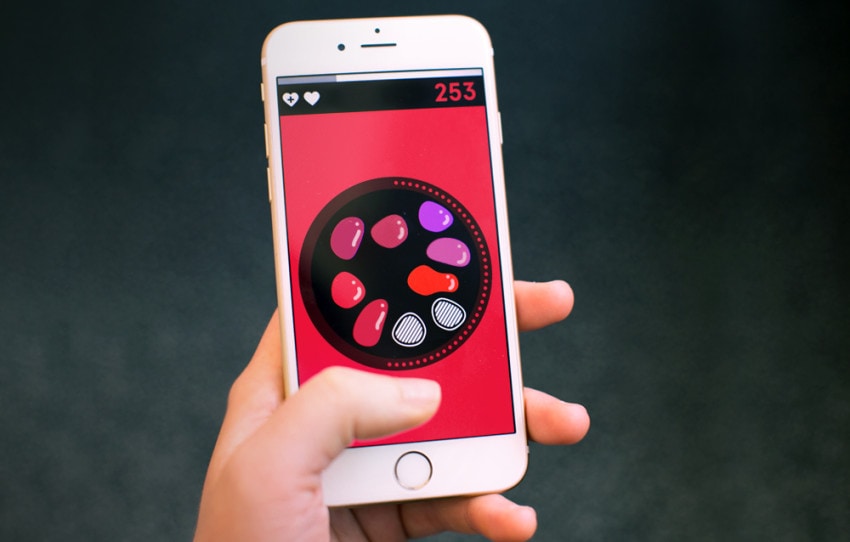
Specimen is a simple but addictive game that challenges players to match colors
Working alongside collaborators Sal Randazzo and Charlie Whitney, Gorochow embarked on a new journey not to become rich or famous — but to learn and grow. (And maybe have a little fun along the way.)
That purity of spirt guided them through myriad challenges and unanticipated obstacles, eventually ushering them to launch the game worldwide in iTunes last week, in conjunction with the NEW INC End of Year Showcase at the Red Bull Music Academy in New York City.
Now that the launch is behind them and the positive reviews are piling up, the team agreed to take a long, hard look back on their process: What worked? What didn’t? Would they do it again? And will they make enough money to buy a sweet Lambo with scissor doors?

The Lamborghini Aventador, definitely not a goal for anyone on the team (Source: Wikimedia Commons)
The following interview contains dozens of juicy insights that designers and developers alike will find helpful and inspiring. Enjoy!
Q&A with Erica Gorochow, Charlie Whitney and Sal Randazzo
First things first: What is Specimen?
Specimen in a minimalist iPhone game about color perception.
This idea has been germinating for a while. How did it all start?
Erica Gorochow Sal Randazzo and I have been long-time collaborators. We’ve put out other utility-focused apps before Specimen: NYU Mobile and Until.
When we were throwing around ideas for new projects in early 2013, Sal mentioned he was interested in making a game so that he could learn a different side of programming. I was hungry to understand how my animation background could translate inside of mobile development.
But neither of us had made a game before. So, I wanted to at least stick to an audience I knew well: designers. I had previously played a color matching game on the web among friends and thought it made for a compelling start. I was surprised to see who aced the test and who struggled.
There were also very specific design challenges that come with making a color game. For example, if colors are the key pieces to the game, how could I design an interface that used color very selectively, if at all?
We did some basic prototyping and then brought on our friend, Charlie Whitney, to shape the the core pieces of the game: the Specimen. I feel like Sal worked on the brain, Charlie worked on the heart, and I worked on the soul.
Who were the primary team members on this, their roles and their “day jobs”?
Erica I’m a design and animation director. My focus is 2D and illustration-driven work. I run a small studio called PepRally.
Sal Randazzo I’m the lead iOS developer at a company called Paperless Post. I did most of the coding, gameplay logic and math involving colors.
Charlie Whitney I’m an artist and programmer. I mostly make interactive experiences for events, parties, and museums. A big part of my job is working with designers and making designs interactive with code and the real world.
Can you give us your brief professional histories?
Erica My background is motion design. I’ve been designing/illustrating boards and wrestling with keyframes for about nine years. I’ve freelanced for the bulk of that time.
Sal I started my career as a VFX compositor (Flame, After Effects and Photoshop). After about four years in the industry, I took a break, moved to Italy with my now wife, and taught myself how to program.
Erica and I kept in constant contact during this time and worked on an app together that we released later that year. It was a success, and that’s when I decided to move from VFX to iOS development.
Charlie I have a studio art degree and after graduation taught myself Flash, which was my first formal introduction to the web. I worked at a couple advertising firms doing web work until HTML5 made everything a template. I’ve been working with code in the real (i.e. physical) world ever since.
Collaboration
One way of conceiving of the three primary team members is like positions on a continuum. At one end of the spectrum, you have Erica representing “pure” motion design (i.e. no code involved). At the other end, you have Sal representing “pure” development (100% code). In the middle, you have Charlie, who acts as a bridge between the two extremes.
Is that an accurate depiction of the team?
Erica Yes, that’s pretty accurate. But we all have a genuine empathy for the challenges we each face.
Sal is an engineer with an eye and a desire to make beautiful work. Conversely, I was genuinely interested in finding a way to apply my animation skills to apps. I didn’t want to just be a helpless designer.
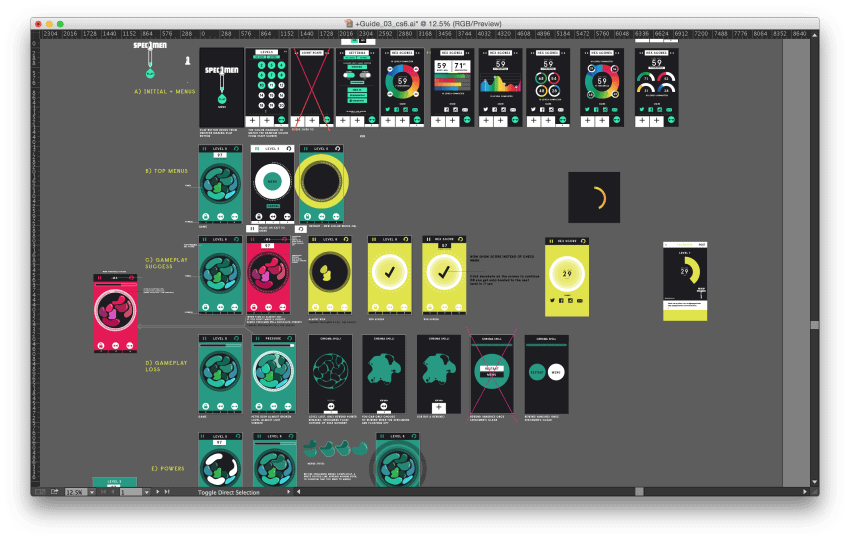
An early attempt at boarding screens for the game
Charlie definitely is a bridge between Sal and I, though. To make the game’s heart, we needed a very special kind of programmer. Someone who worked with more visually-oriented code to handle the personality of the specimen. It was crucial that the specimen feel like vector amoebas come alive.
Charlie might hesitate to call himself a designer, but I think of him as one. (He probably knows more about typography than I do.)
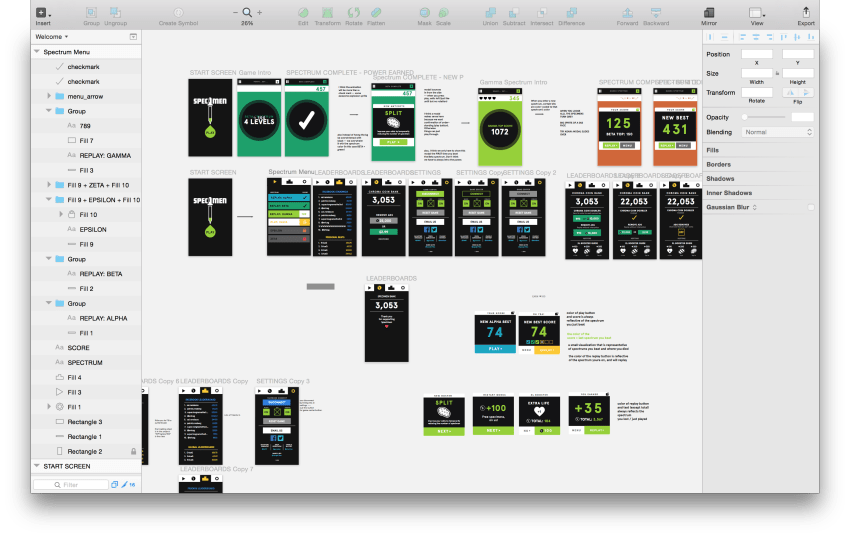
A sketch board of the near final version of the game
Charlie I actually have a Webby for a site I helped design many years ago, so I’ll totally take the designer title. I also love typography as much as I do getting into the dirt with openGL.
However, Erica and Sal both represent places my brain can’t go in design and architecture respectively. Instead of thinking of myself in-between them, I almost like to think of us as each being on separate X, Y and Z axes from one another, where we all cross in the center.
Sal I can recognize, appreciate and fall in love with great design, but stick a stylus in my hand, and I’m at a loss. It was a pain point of mine when I sat down to code something great.
I had the tools, I had the knowledge and I had the desire to make something that felt magical — I just didn’t have the talent to make it look great, which is where Erica and Charlie worked their magic. I really couldn’t have asked for a better set of partners!
What were some early workflow habits that didn’t work?
Erica As an animator I wanted every little thing to have a flourish. Translating animation curves from AE to code isn’t simple. (It’s why I really respect Marcus Eckert).
What didn’t work was my initial naiveté. Code isn’t magic. Understanding what was cheap and what was expensive to build, has been critical to actually shipping the game.
I was responsible for tactically guiding the project through the weeds. Showing testers non-pixel-perfect designs made me cringe, but I’ve learned to get over it. Don’t risk polishing a rock. Get an indicator you’ve got a gem before you refine.
Charlie Going from motion to code in our specific instance was an extreme exercise of back and forth. Apart from matching timing cues, we had to make it all interactive. There was no predefined workflow, but the amount of iteration absolutely allowed us to narrow in on something where we both were able to admire the aesthetics and interactivity.
There’s a great deal of — anxiety? interest? — from the motion design community about the growing role that interactive experiences are playing in the industry. Do you share that anxiety/interest?
Erica I don’t personally want to make apps for clients, but having a real grasp of interactive can only lengthen my career and give me more options. Part of why I want to make apps as side projects is because there is a market for your output. That said, the economy of the Apple App Store, especially mobile games, can be wonky — even gross — and is certainly evolving.
I also wanted to make my own work, but I found it hard to work on animation during the day and then come back to just animation in my spare time. I wanted to be a beginner again and feel like I was growing.
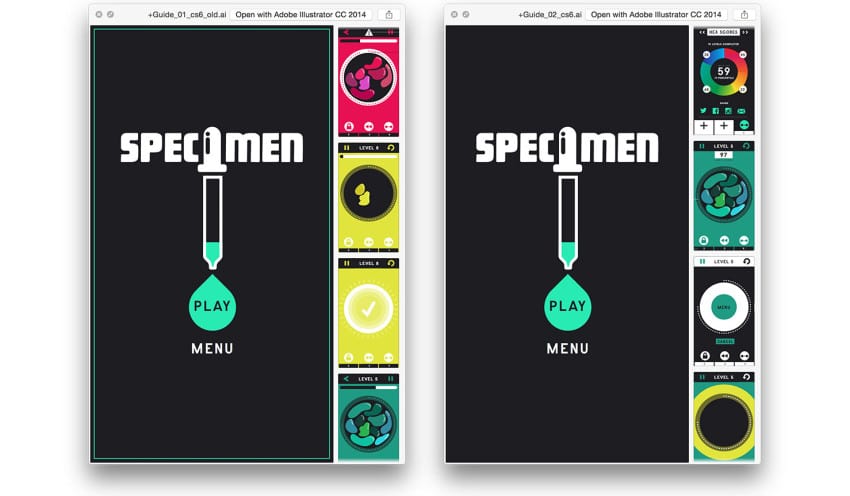
Early designs by Erica Gorochow
Charlie As a coder who has been working with really talented motion designers for 10 years, I always look forward to working with talented people who have never worked in interactive before. I don’t see the need for great designers abating at all. In fact, as the tools begin to connect skillsets, I think we’ll be seeing some of the best projects yet in the near future from such collaborations.
Erica: Did you end up learning how to code through the course of this project?
Erica No, but I’m certainly less helpless. I would say I can mostly read and not write. And I can use Git, which is liberating.
Did you feel your lack of coding experience was a major roadblock?
Erica If I could code, it would have certainly made the project easier and faster to execute. “Roadblock” feels too strong, but there were times I yearned to just dig in and focus on getting things as perfect as they were in my AE files. That said, I am extremely proud of where we landed.
For motion designers wanting to make a game with little to no coding experience, what advice can you give them?
Erica I think you have two options.
You can be like Marcus Eckert and spend a year focusing on one project to teach yourself how to code. (Again, respect to Marcus!)
The other option: Find a developer you want to work with by offering to first work on their idea. As I mentioned, Sal and I have worked together before. The first app we made was an app called NYU Mobile. When we made it, Sal was just graduating from school. I didn’t have a vested interest in NYU, but I wanted to establish a real working relationship and help him.
In the case of Specimen, Sal came to me saying he wanted to make a game. Don’t think of programmers as just executors of your idea.
Charlie: What advice can you give to motion designers for working with coders?
Anytime something is confusing, ask them to slow it down. Coders love to blow through technical details that almost certainly can be explained more simply. Get to know where your skillsets intersect, and if you can drop a video or PNG sequence somewhere instead of trying to re-time an animation in code, do it!
Were you guys all working together in the same physical space? Is that important?
Erica Charlie and I have been working full-time out of NEW INC for the past year. Specimen was a side-project for everyone. So having a consistent hub in light of an inconsistent work schedule was helpful.

New Inc is a curated coworking space for people working in the areas of art, technology, and design
Sal would come in every so often to have a full-on Specimen work day. NEW INC helped make the project more real. In some way, the space provided the stakes to get it done. Mostly, though, the team works over Slack, Dropbox and Github.
Charlie I think there is a lot of value in the smalltalk and lunch conversations that go into getting something done. While tools are much better about connecting us, all the Giphy links in the world can’t replace being line-of-sight with one another.
Finding the fun
I have a little experience (very little) developing games, and the part that I found most difficult was the part I expected to be the easiest: making it fun. Does this resonate with you?
Erica Lord, yes. Patrick Moberg from Dots gave me advice that someone said to him: You can’t fake fun.
A core mechanic that isn’t fun is like a lousy script. It’s hard to make an outstanding movie if the story isn’t there. Looks won’t save you. And like a good story, understanding just what makes a game fun is a bit mysterious and magical.

Mapping user flow
Charlie I’ve made a lot more bad games than good ones, and that’s why they never come out. This is the first game I’d ever worked on where I was with a team that pushed hard enough past the cruft and found the fun inside.
How do you deal with “fun blindness” — the reality that as you work on something, you become incapable of seeing it the way fresh players see it?
Erica We tried to constantly give it to new people to test. We also resisted the urge to walk anyone through how to play: we just watched. To the “you can’t fake fun” point, if someone contorted their face or didn’t give you your phone back right away — that was a great sign. We’re still learning how to cope with this, though.
Charlie Even when you don’t enjoy it as much as you used to, there is still a part of you that knows when something is good. It’s the same feeling as working on a video or installation for a long time, and having to keep a channel of empathy open to your imaginary players.
People talk about the iterative nature of game development. Practically speaking, what does that mean? You’re not banging out style frames over and over, right?
Erica I did bang out several version of animated prototypes. It’s a lot cheaper to spot logic flaws in that phase than in code. Our general policy was:
Jam it in → Is it fun? Does it solve the problem? → Rip it Out → Try something new → Arrive at solution → Refine.
Sal The single best piece of advice I could give to developers making their first game: just hack it. In the early stages, I spent a lot of time writing some really beautiful, well-tested, well-designed code. Games do not turn out the way you start them, and all that code no longer exists.
How much did the game change from the original concept to the final concept?
Erica The core elements of the game — the petri dish, the timer, the blobs, the eyedropper — were all there from day one.
But originally, the game was half diagnostic, half game. We even developed an algorithm with my NEW INC neighbor, Luisa Pereira, that identifies strengths and weakness across red, yellow, green and blue. (We plan on bringing that back for the 2.0).
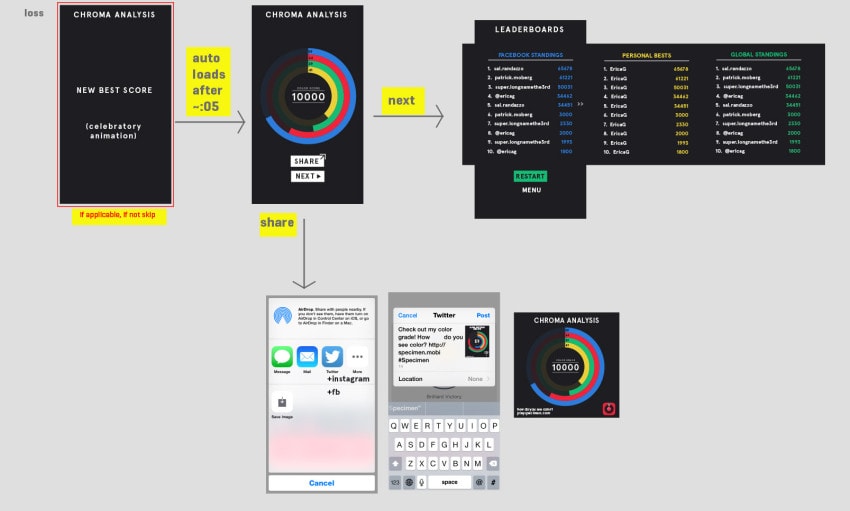
Originally, the game was designed to inform users about their perceptual biases.
What we found was we had to choose to prioritize for fun. We had to kill our darlings and make a game you wanted to replay. A key piece of advice we got from Eric Zimmerman was, “If you’re going to be a bear, be a grizzly.”
Were there any features that you initially avoided but later came to embrace?
Erica In-game ads, to some degree. We really wanted the game to be free, but we also wanted to be able to see some return. I was hesitant to make a game where you died so quickly (thanks, Flappy Bird!), but now that feels like an obvious choice.
Do you feel the spirit of the original concept is still alive in the final game?
Erica Even though we don’t exactly have the quantified-self aspect in version 1.0, I think the spirit is still very much alive. We wanted to make something quick to pick up, beautiful, fun and widely appealing. I think Specimen lives up to those desires.
Technically speaking, what were the most challenging parts of the project?
Erica For me, it is was trying to balance everything we wanted to do with everything we could do without making the project run another year.
Charlie The vast majority of my time was spent making those little blobs! We started off with a lavalamp type of interaction and ended up in a more spring based physics world.
The character of these blobs was so important to the feeling of the game. If they didn’t match the bright colors or the music (created by Upright T-Rex), it would have thrown the vibe of the game off in a big way. Hopefully, you don’t even notice them now.
Aside from solving physics problems, we also had to make sure they weren’t able to overlap or intersect, and that they always spawned in locations where there weren’t other specimen. Every bit of them is dynamically made when they spawn, and each has slightly different characteristics, which is very important to their feel.
Hopefully, they land somewhere between splats of paint and sentient creatures — something you might find in a petri dish.
Launch and beyond
Can you explain your launch strategy? You didn’t just go straight to a worldwide launch in iTunes. Why was that?
Erica So this is pretty common practice now, but we tested the app in South Africa and Australia in June. Bigger game shops do that to determine if a game is worth developing. We were mainly looking for bugs and crashes, so we weren’t a total mess on day one.
What does “success” look like for Specimen?
Erica If I see someone playing this on the subway, that will be success. (Hint: I ride the F line.)
If someone made fan art: that would be incredible. (Not sure how you’d do that, but…) If we can generate enough money so that we could continue evolving the game, that would be outstanding. But honestly, success is shipping.
Would you do this again? If so, what would you do differently?
Erica I would absolutely work with Sal and Charlie again. I wouldn’t rule out making another game, but I don’t feel like I’m going to become a full time game designer. I’m interested in making something 2D and weird in Unity. Specimen was a creative marathon for all of us. I’m glad I know I can go the distance and see an idea that’s strictly fueled by personal motivation, through.
Charlie If anything, I think working on a mobile platform was a big challenge for a first project. There is so much baggage that comes with distributing applications and signing certificates and provision files. Sometimes you just want to send someone an app or executable file and be done with it. In the future, being able to iterate away from the phone would be a big one for me.
I would definitely give it another run, though. I’d really love to try something narrative where I too can get a bit weirder and more experimental with code. I think it’s inevitable that I’ll end up working with one or both of these guys again.
SAL I would do it again, but with a completely different approach and set of expectations. Software can be hard, but making games: near impossible. You have to challenge every “good idea” you have, play test it, and be ready to throw it out. Making games is not about the great code or flashy graphics, it’s about fun. And like Erica mentioned earlier: You can’t fake fun.
I think we all learned a ton about game development, code, graphics, marketing and beyond. But the hardest part for me remained “making it fun.” The next time Team Specimen collaborates on something new, if it does end up being a game, I don’t think we’ll immediately figure out how to make it fun, but I definitely know we will be able to recognize not fun a lot sooner.
Credits
Specimen is a game by: Erica Gororochow, Sal Randazzo and Charlie Whitney.
Download the game for free
Animation by: PepRally
Sound + SFX: Upright T-Rex Music







